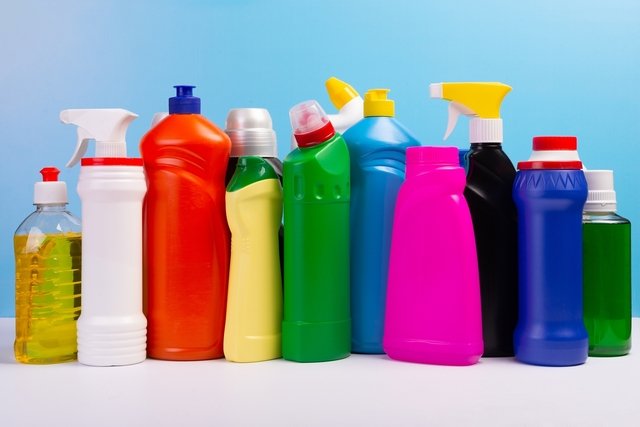If the detergent is ingested, it is important that SAMU is called and that you contact the poisoning center indicated on the product label so that you have guidance on what should be done. It is important not to drink liquids or eat, as this can promote greater absorption of the product and cause complications.
Despite being used daily, detergent is a potentially dangerous product, especially if ingested, as detergent contains substances in its composition that are toxic and irritating to the body, such as phosphates, silicates, stain removing agents and foam modifiers, dyes and artificial fragrances and alcohols.
Although this accident can happen to adults, it is more common in children and, therefore, it is important that cleaning products are stored in a place that is difficult for children to access and that they are kept in their original packaging, as this way, if there is a accident, it is possible to provide more accurate information about the product ingested.

What to do
When ingesting a small or large amount of detergent, there may be health consequences, and it is important that first aid is initiated:
- Call SAMU immediatelydialing the number 192, if the person is not conscious;
- Call the poison center number indicated on the product label, so that appropriate guidance is available, and it is important to indicate the product and quantity ingested and symptoms presented;
- Keep the person comfortable until help arrives.
It is recommended that water or milk is not given, as there may be greater absorption of the product, increasing the risk of consequences, and it is not recommended to induce vomiting.
How is treatment carried out in the hospital
The medical treatment carried out in the hospital depends on the type of detergent consumed, quantity of product and symptoms presented. Typically, the person remains hospitalized so that their heart and respiratory rate, blood pressure and amount of oxygen are monitored. In some cases, it may be necessary for the person to remain in the hospital for up to 2 days to check for a worsening of their health condition.
Additionally, during treatment, the doctor may recommend:
- Remedies to avoid vomitingsuch as metoclopramide or activated charcoal;
- Wash your stomach to remove the toxic product;
- Give serum into vein to maintain water and electrolyte balance;
- Give medicine to treat seizures with diazepam and if necessary medicines to keep the heartbeat stable;
- Use oxygen mask to help you breathe better or use other devices to help you breathe.
In the case of children, it is common for parents to be able to accompany the child to the hospital, helping to control anxiety and fear.
Main consequences of ingesting detergent
Depending on the type of detergent and the amount ingested, it can cause damage, such as:
- Irritation of the throat, eyes or nose;
- Burn in the esophagus;
- Decrease in blood pressure;
- Injury to the respiratory tract;
- Changes in blood pH, causing organ damage;
- Burns to the skin and areas exposed to detergent;
- Gastric ulcers.
Ingesting the detergent can have serious consequences that can be life-threatening, and the person should be treated by an emergency department as quickly as possible to avoid permanent consequences.
Detergents contain several ingredients in their composition, such as sodium hypochlorite, ammonia, sodium hydroxide, acetic acid, hydrochloric acid, dyes and solvents, which serve to dissolve stains, whiten clothes and remove grease, for example, and, Therefore, when this product is consumed it can cause various damages to the body.
Symptoms of detergent poisoning
The main symptoms indicative of detergent poisoning are:
- Strange-smelling breath;
- Lots of saliva or foam in the mouth;
- Belly pain, nausea and diarrhea;
- Vomiting, sometimes with blood;
- Difficulty breathing;
- Bluish and pale face, lips and nails;
- Cold and sweats;
- Agitation;
- Drowsiness and lack of desire to play;
- Delusions with meaningless conversations and strange behaviors;
- Fainting;
- Severe pain in the esophagus;
- Loss of vision;
- Pain or burning in the nose, eyes, mouth, tongue and ears.
Symptoms of detergent poisoning can vary according to the amount consumed and the person’s age, with children being more likely to experience more severe symptoms.
In the case of a child, if you have not seen him ingesting the detergent but he shows some of these symptoms or finds the container open, ingestion may be suspected and you should act in the same way, asking for medical help quickly.
How to prevent
To prevent poisoning from detergent or other cleaning products, it is important to store in a place that is difficult for children to access, keep product labels on and keep them in the packaging, avoiding using food containers or other empty packaging for storage. Furthermore, it is recommended to avoid storing cleaning products close to drinks or food.
Bibliography
- STANDFORD MEDICINE. First Aid for Poisonings in a Child. Disponível em: <https://www.stanfordchildrens.org/en/topic/default?id=first-aid-for-poisonings-90-P02815>. Acesso em 12 abr 2023
- MOUNT SINAI. Detergent poisoning. Disponível em: <https://www.mountsinai.org/health-library/poison/detergent-poisoning#:~:text=Swallowing%20such%20poisons%20can%20have,months%20after%20substance%20was%20swallowed.>. Acesso em 12 abr 2023
- MEDLINEPLUS. Detergent poisoning. Available at: <https://medlineplus.gov/ency/article/002777.htm>. Accessed on April 12, 2023

Sign up for our newsletter and stay up to date with exclusive news
that can transform your routine!
Warning: Undefined array key "title" in /home/storelat/public_html/wp-content/plugins/link-whisper-premium/templates/frontend/related-posts.php on line 12
Warning: Undefined array key "title_tag" in /home/storelat/public_html/wp-content/plugins/link-whisper-premium/templates/frontend/related-posts.php on line 13



